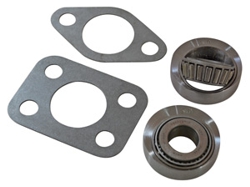Actually, at 1.7* of castor change per inch of lift, and running large tires like 37’s, aftermarket radius arms dialing in 10-12 degrees of castor would be great.
Castor plates for a 4” lift or radius arms for a 6” lift bring castor barely back into Toyota’s conservative spec of 2* which isn’t really enough for a lifted rig on larger tires.
3” x 1.7* = 5.1*
Assume you stared at +3*, you are now at -2.1*. A set of 4” castor plates correcting would be a wise choice. Anything over 4” then go for the after market radius arms to get to a more positive castor number like 6* to help drive the bigger tires. Or, move the tie rod to the front and do a cut and turn of the knuckles to dial in proper castor for a lifted rig sporting big rubber.
I have 5” lift with 4” castor plates and about .5* of positive castor. For the money, I’m thinking that a set of those Black Mamba drop boxes might be a great deal for getting back about 3* of castor.
Dropping your control arm mounts is great if you don’t have to back up. If you do have to back up, then you’ve created a a forward mount drop bracket that is worse than the rear lower control arm frame mount hangup points.
Since the low hanging frame is the 80’s Achilles heel, making it lower isn’t a very good idea, at least to the extent we are talking use of 37’s.
Aside from this, unless you are willing to have driveline vibes, caster is not an independent variable and has to follow driveshaft alignment. Yes, you can go part time, but unless you won’t ever drive at highway speeds in 4WD (a non-winter climate), pinion angle is going to rule over arbitrary caster modifications. This is the single most vexing issue in the 4x4 world that pins people to lower lifts.
A singular beauty of the 80 is that the stock broken back conversion to DC shaft allows proper caster and pinion angle on a 4” lift (by proper I mean it drives straight down the highway at 80 mph). This is also the reason that there is no reason to work so hard to stay lower on an 80 when the low frame needs all the help it can get.
Except that the rear driveshaft is really short for the wheelbase and loves to make noise.
Bummer.
Last edited:

 then don't breach the 3" threshold. (but this is a caster correction thread so I retract my previous statement to prevent derailment of my own thread).
then don't breach the 3" threshold. (but this is a caster correction thread so I retract my previous statement to prevent derailment of my own thread).



